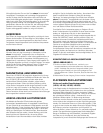
LS-C50/LS-C100
When the LS-C50/LS-C100 is used as a center speaker, it is ideally
placed as close to the center of the TV or video projector as
possible. This is to ensure that voices and all sounds come from
the performer's placement on screen. This may be on top,
underneath, or on a shelf within a wall unit or other furniture. Use
the position that provides the best sound quality, but keep in mind
safety and room décor as well. The center channel works best
when the front of the speaker is flush with the TV, or the shelf it
rests on. If the center speaker is recessed in its placement, it will
sound distant, and undefined in character.
When the LS-C50/LS-C100 is to be installed on top of a television,
in a cabinet or on a shelf, please use the included table top mount.
Please see diagram 4.
FINE TUNING
Before beginning any fine tuning, please ensure all connections are
properly made and your speakers have had the chance to break-in
for a minimum of 100 hours. This will ensure the proper results are
achieved.
Your listening room is the final component of your audio system
and will be the difference between mediocre sound and high quality
sound. Reflections, which are a part of every recording and music
playback, will have a major effect on your system's performance. If
your room is too “live”, meaning there are many bare surfaces like
glass windows, hard floors and thin furnishings, you might find the
sound overly bright. If your room is “dead”, meaning there is thick
pile carpeting, heavy furniture and a lot of wall coverings, you might
find the sound lacks dynamic energy. To remedy these issues, small
changes to your room should be considered as they generally lead
to large improvements in sound quality. Most listening rooms must
balance aesthetics and sound, but patience and small adjustments
in positioning and settings can pay huge acoustic dividends.
The lower bass frequencies are typically the most influenced by
your listening room. If you find the bass in your room to be uneven
or exaggerated in certain frequencies, experimenting with
placement of the front speakers or their orientation towards the
listening position can alleviate some of these issues. The proximity
of the speakers to room boundaries, like walls, will also affect the
bass frequencies. If you find your system lacks bass, first check
your connections to make sure your system is in phase, then
experiment with placement. The further from the wall, the less
overall bass output your system will have, but the bass will
generally be better defined. If you position your speakers too close
to a room boundary, the bass will typically be exaggerated and ill-
defined. Adjusting your speakers to your room will generate the
best results.
If you are experiencing issues with imaging, first ensure your
speakers are in phase with each other. If this is the case and
imaging is still an issue, moving the speakers closer together or
toeing them in slightly (angling them towards the listening position)
can aid in this respect.
When installing a surround sound system, all the above holds true.
Calibration of your speaker distances, adjusting delays and
balancing your levels with an SPL meter are necessary to extract
the most out of your system.
CARE OF FINISH
The LS Series cabinets should be gently cleaned with only a damp
cloth and warm water from time to time, in order to remove any
dust or fingerprints. Do not use an abrasive cleaner, or any type of
ammonia based cleaners, or window type cleaners. To remove the
dust from the grille cloth, use the brush attachment on your
vacuum cleaner or a slightly dampened sponge or dust free cloth.
Do not touch the speaker cones directly or enter them in contact
with water or cleaning materials, as this can cause irreparable
damage.
3
owners manual


















